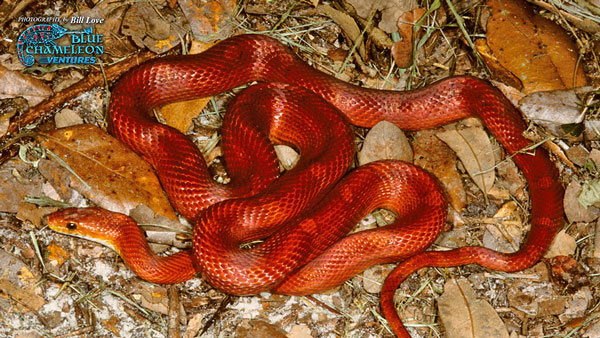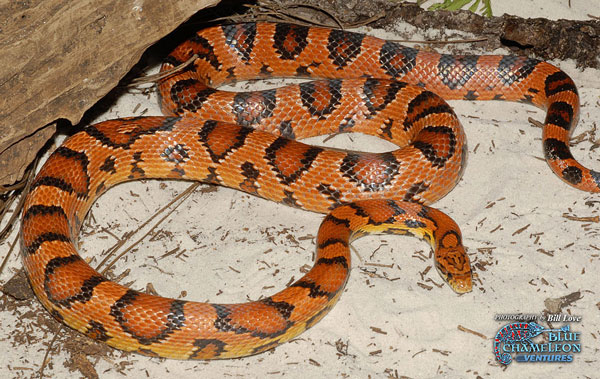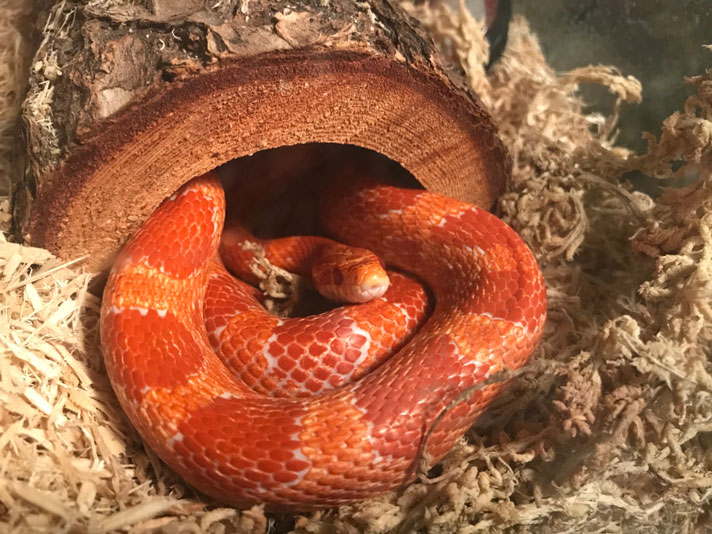Care sheet for the corn snake Pantherophis guttatus (Elaphe guttata).
Updated January 21, 2025
Corn Snake – Pantherophis guttatus (Elaphe guttata)
Corn snakes are one of the most popular of all pet snakes and for good reason. Their extremely variable and gorgeous colors and patterns, ease of care and breeding, and generally docile dispositions have earned corn snakes their rightful, premier place in herpetoculture. The size of mature corn snakes is just right: big and hardy enough to accept regular handling, yet not large enough to intimidate a novice or child. Easy to breed and care for with an endless array of genetic traits, corn snakes offer something for the newest snakekeeper, yet they also challenge those with years of experience.
Corn Snake Availability
Corn snakes are readily available at pet shops, reptile expos, online reptile shops and directly from breeders. Although wild-caught specimens usually adapt as pets, captive-bred corn snakes are highly recommended because of the beautiful color and pattern morphs available; the greater likelihood of getting a healthy, parasite-free snake; and the details about age, history and parentage that may accompany them.

Photo Credit: Bill Love
Blood red corn snake.
Corn Snake Size
Corn snakes hatch at 8 to 12 inches long, and most eventually reach 4 to 5.5 feet in length.
Corn Snake Life Span
With proper care, a corn snake could live at least into its latter teens, and it may well live into its 20s. They are often reproductive until 10 to 12 years of age and sometimes longer.
Corn Snake Caging
Baby corn snakes can easily live in a plastic vivarium the size of a large shoebox for the first several months of their lives. Adult corn snakes need a cage at least the size of a 50-gallon long reptile terrarium, but bigger is even better. Snakes are not social animals, so cagemates are quite stressful. House only one corn snake to a cage. All snakes are escape artists, so make sure the cage is absolutely escape proof. Snake habitat products like climbing branches may be appreciated, but a couple of dark, tight reptile hides are essential to help the snake feel secure.
Corn Snake Lighting and Temperature
Natural light from nearby windows will help your corn snake adjust its day and night cycles, and its seasonal cycles. Be careful to avoid direct sunlight shining into the cage, or the temperatures could quickly become lethal.
(Editor’s note: The corn snake is a partial sun/occasional basker. It is a Zone 1 reptile under the Ferguson Zones. These zones are based on Dr. Gary Ferguson’s observations of how reptiles interact with sunlight in the wild. Choose a UVB light that offers a Zone range of 0.7 to 1.4 with a maximum UVI of 1.1 to 3.0 in the basking zone).
Provide a temperature gradient with a light, or undertank heat pad or cable. On the warm end 85 degrees Fahrenheit is perfect, and room temperatures (low 70s) are fine for the cool end. One long, skinny hide, such as a hollow log or PVC pipe, can be placed so one end of the hide is cool and one end is warm. Be sure to check the temperature inside the warm end of the hide — not on the glass. Temperatures can vary quite a bit within just a few inches, so thermometer and hide box placement is important.
How To Choose And Care For A Corn Snake
Misting the enclosure often causes fungus and mold. If the corn snake sheds its skin in pieces, increase humidity inside the hide box by adding a clump of damp moss or paper towel whenever the snake prepares to shed. Remove this damp filler in between sheds to avoid buildup of bacteria, mold, etc.
Corn Snake Substrate
Most breeders use aspen shavings as bedding because it is absorbent, soft and holds its shape when snakes burrow. Cypress mulch also works, but avoid aromatic woods such as pine or cedar. Newspaper and reptile carpet also suffice, but the corn snake tends to get under it whenever possible. Avoid sand because it may cause impactions if ingested.
Corn Snake Food
The primary natural food of corn snakes is appropriately sized rodents. Some baby corn snakes also eat lizards or an occasional frog. Adult corn snakes may eat birds or their eggs. Do not offer crickets because corn snakes don’t recognize them as food.
Hatchlings normally eat newborn mice. Increase to a jumbo mouse for a large adult corn snake. Most corn snakes learn to eat previously frozen, but fully thawed out, mice. Be prepared to offer a live newborn mouse to baby corn snakes stressed by a new home or not used to thawed mice yet. It usually won’t take many times to train them to take thawed mice. Placing your corn snake and a thawed mouse in an empty container with a few air holes and closing the lid will help the snake concentrate on the food, and encourage it to eat. Be sure the lid is on tightly, and don’t put it near a heat source, or you risk overheating the snake. Cuts made into the skin of a thawed mouse ensure faster and more complete digestion. Feed baby corn snakes once every five to seven days, and feed adult corn snakes once every seven to 10 days.

Okeetee corn snake. Photo Credit: Bill Love
Corn Snake Water
Fresh water should always be available in a shallow, heavy reptile water bowl. Clean out the bowl every few days or sooner if it is soiled. Place the bowl in a cage corner so it can be easily found as the snake cruises the cage perimeter at night.
Corn Snake Handling and Temperament
Hatchling corn snakes are naturally nervous and defensive. Fearless babies were eaten quickly long ago and never passed their genes onto future generations. Although it is normal for baby corn snakes to flee, hide or defend themselves, it is also true that they have no real ability to harm you. A white mouse or a cat that plays too roughly with its owner can do far more damage than even the largest corn snake.
It is important to give a new corn snake a few weeks to settle into its new home and into a regular feeding routine before stressing it with unnecessary handling. After three or four successful meals, start handling your corn snake for short periods, except for the first two to three days after a meal. Be sure to approach the corn snake from the side rather than the top like a predator would do. Lift it up gently but with confidence. Hesitation scares the corn snake, and makes it likely to hide or bite. If needed, use lightweight cotton gloves to bolster confidence for as long as needed. Once the corn snake begins to realize that you are not going to eat it, and also that it needs to calm down to regain the security of its quiet cage, it will usually tame quickly and become very used to handling.



